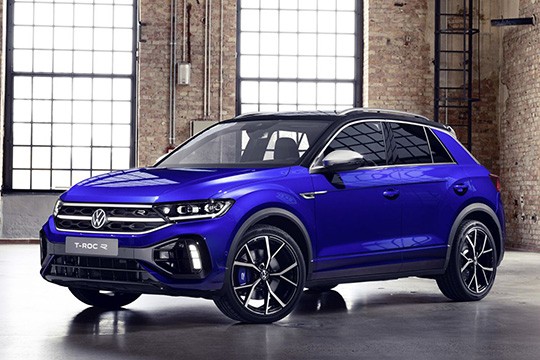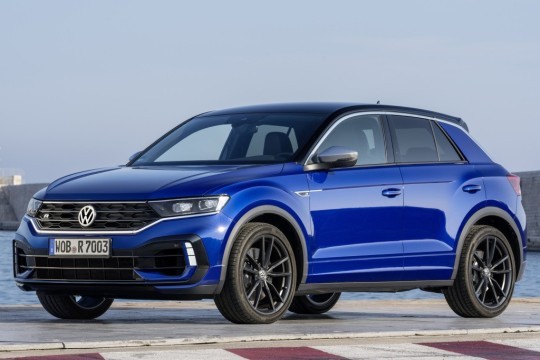VOLKSWAGEN T-Roc R Models/Series Timeline, Specifications & Photos
First production year: 2019
Engines: , Gasoline
Body style: SUV (Sports Utility Vehicle)
Volkswagen refreshed the entire first generation of the T-Roc lineup for the 2022 model year, and the changes also affected the R-version.
In late 2021, Volkswagen introduced the updated version of its B-segment crossover in all of its versions, including the most potent one, named the T-Roc R, which was added to the lineup in 2019. This hot hatch on stilts shared its underpinnings with the Golf R and provided a higher ground clearance. While it was not a sports car, it could still give some thrills to its customers and was more capable of dealing with gravel roads than its hatchback sibling. Along with the facelifted version, the T-Roc R gained a more aggressive stance and some interior upgrades, but not a pony more under its hood.
At the front, the 2022 T-Roc R boasted a new grille adorned by three satin-chromed horizontal slats and a honeycomb mesh between them. The one in the middle was visually extended inside the headlights by the daytime running lights that also doubled as turn signals. In addition, the lower bumper gained a new styling, sporting an A-shaped lower air intake with a single horizontal slat flanked by side scoops that housed the three LED blocks for the second set of daytime running lights.
With a profile of a sporty hatch on stilts, the T-Roc R had some details that differentiated it from its non-R siblings. Firstly, its ground clearance was lowered by 20 millimeters (0.8-inch) compared to the rest of its stablemates. The T-Roc R sat on 18-inch alloy wheels as standard, but Volkswagen offered it with a 19-inch set. Like any R-line vehicle from the automaker’s range, this pumped-up version of the T-Roc sported specific chromed badges on the front fenders. Out back, the automaker installed new taillights sporting signature LED blocks with inwards tilted blocks. Finally, under the bumper, the automaker replaced the fake round tips with angular-shaped ones for the standard version, while those who opted for the Akrapovic titanium pipes got real round exhausts.
Inside, the T-Roc R boasted sports seats with integrated headrests, specific Alcantara, and leather upholstery. The flat-bottom steering wheel was new, with more buttons on it than the center stack. Fronting the driver was a 10.25 Digital Cockpit Pro TFT display for the instrument panel, while atop the center stack, Volkswagen placed the 9.2-inch touchscreen for the Discover Media infotainment system. In the back, the automaker installed a split-folding (60/40) bench seat that could expand the trunk space from a regular 392 liters (13.8 cu-ft.) to 1,237 liters (43.7 cu-ft.).
Under the hood, the T-Roc R carried over the 2.0-liter engine from the Volkswagen Golf GTI paired with a seven-speed automatic (dual-clutch). The 300 PS (296 hp) were sent in all corners via an electronically-controlled all-wheel drive system tuned to send most power to the front wheels.
While the horsepower race is usual in the sports car or supercar segment, it was unusual in the small-sized crossover area. And yet, Volkswagen threw the gauntlet at its competitors with a pumped-up version of the T-Roc.
When Volkswagen developed the MQB platform, it created it for many vehicles built under its umbrella, including hatchbacks, station wagons, SUVs, and crossovers. As a result, it made the T-Roc under its own badge, and then it just spiced it up with a drivetrain carried over from the famous Golf R. The result was named T-Roc R and was one of the fastest crossovers on the market in 2019.
While the regular T-Roc looked like a vehicle designed for school runs, its R sibling tried to be more than that and show it. As a result, the front bumper was deeper and sported big side scoops that cooled the radiators behind them. In addition, the automaker mounted vertical LED daytime running lights instead of the rectangular ones as featured on the T-Roc. Furthermore, the apron sported a broad grille that complemented the tiny cooling area from the upper one.
To further emphasize the crossover’s sporty character, Volkswagen added a chromed R badge on the grille. Customers could get the subcompact crossover with 19” light-alloy wheels wearing 235/40 tires. The silver caps on the door mirrors were standard, but the black roof was an option. Finally, at the back, Volkswagen installed four exhausts grouped by two on each side of the vehicle, under the bumper, flanking a piano-black diffuser.
The interior was upgraded compared to the regular T-Roc with the addition of high-bolstered bucket seats at the front that provided excellent side support during high-speed cornering. For the instrument cluster, Volkswagen opted for a configurable digital display that could show the map or the dials and other information coming from the car’s onboard computer. Atop the center stack, between the vertical vents, the T-Roc sported the touchscreen for the infotainment unit featuring Apple CarPlay and Android Auto.
Drivers were spoiled with a flat-bottom steering wheel and aluminum pedals. In the back, the automaker installed a split-folding bench seat fit mostly for two adults due to the tall transmission tunnel and the center console. This could expand to provide additional room for the 392-liter (13.8 cu-ft) trunk.
But the real upgrade for the T-Roc was under its skin, where Volkswagen basically took the drivetrain from a Golf R and installed it. As a result, the R version of this subcompact crossover got a two-liter turbocharged inline-four powerplant paired with a seven-speed automatic (dual-clutch) transmission with launch control.
Power went in all corners via a Haldex system, meaning that most of the time, the car was front-wheel-drive, and when needed, the electronic system that controlled the transmission could send up to 50% of the power to the rear wheels.

